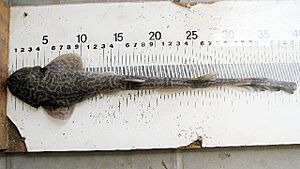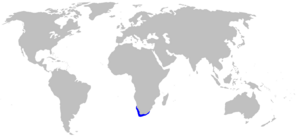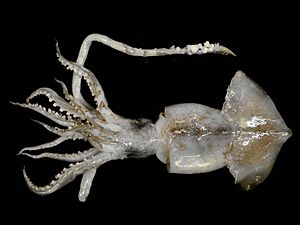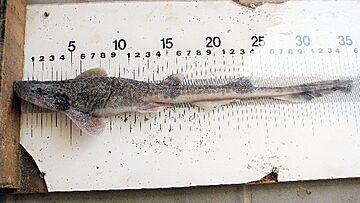Izak catshark facts for kids
Quick facts for kids Izak catshark |
|
|---|---|
 |
|
| Conservation status | |
| Scientific classification | |
| Genus: |
Holohalaelurus
|
| Species: |
regani
|
 |
|
| Range of the Izak catshark | |
| Synonyms | |
|
Scylliorhinus regani Gilchrist, 1922 |
|
The Izak catshark (Holohalaelurus regani), also called the Izak, is a type of catshark. It belongs to the Scyliorhinidae family. This shark is often found near the coasts of South Africa and southern Namibia. It usually lives on the outer part of the continental shelf, in waters from 100 to 300 meters (330–980 feet) deep. Male Izak catsharks tend to live in deeper waters than females and young sharks.
This shark has a short, wide, and flat head. Its body is strong and gets thinner towards a long, slender tail. You can recognize the Izak catshark by its unique color pattern. Young sharks have dark brown spots on a light yellowish background. Adult sharks have a more complex pattern of dark lines and blotches. They also have special, larger skin denticles (like tiny teeth on their skin) over their pectoral fins. These denticles also run along their back from the snout to the second dorsal fin. Izak catsharks can grow up to 69 centimeters (27 inches) long, with males being larger than females.
The Izak catshark lives near the ocean bottom and might be quite active. It mainly eats different kinds of bony fishes, crustaceans (like crabs and shrimp), and cephalopods (like squid and octopus). They might also eat leftover food from fishing boats. This shark lays eggs, with females producing two egg capsules at a time, all year round. Fishing boats in South Africa often catch Izak catsharks by accident. However, these sharks are usually thrown back into the ocean. Even with fishing, their numbers have been growing. Because of this, the International Union for Conservation of Nature (IUCN) lists them as a species of Least Concern.
Contents
About the Izak Catshark Name
The Izak catshark was first described by a South African scientist named John Gilchrist in 1922. He was studying fish for a fisheries report. Gilchrist named the new species regani to honor another fish scientist, Charles Tate Regan.
Later, in 1934, Henry Weed Fowler placed this shark into a new group he created called Holohalaelurus. This group was first a subgenus, but it is now considered a full genus. Scientists sometimes had trouble telling the Izak catshark apart from other similar species. In 2006, a scientist named Brett Human helped clear up some of this confusion.
What the Izak Catshark Looks Like
The Izak catshark has a firm, strong body that gets much thinner towards its tail. Its head is very short, wide, and flat, with a blunt snout. The eyes are oval-shaped and sit high on the head. They have thick ridges below them and a small eyelid-like membrane. Behind each eye is a small hole called a spiracle.
Its nostrils have small, triangular skin flaps that almost reach its long, angled mouth. Inside the mouth, there are small bumps called papillae on both the top and bottom. The shark has many rows of teeth, about 65 in the upper jaw and 60 in the lower jaw. Each tooth is fairly large with a sharp point in the middle and one or two smaller points on the sides. It has five pairs of gill slits.
The pectoral fins are quite long and wide. The first dorsal fin starts above the back of the pelvic fins. The second dorsal fin is a bit larger and starts above the back of the anal fin. Both the pelvic and anal fins are long and low, and bigger than the dorsal fins. The back tips of the pelvic fins can be partly joined, but never fully. Male sharks have thin, pointed claspers for reproduction.
The part of the body before the tail fin, called the caudal peduncle, is long and thin, especially in younger sharks. The caudal fin (tail fin) makes up about one-fourth to one-fifth of the shark's total length. It has a weak lower part and a small notch near the tip of the upper part.
The shark's thick skin is covered in hard, tiny denticles, except around the gill slits. Larger, spike-like denticles are found on top of the pectoral fins. They also run along the middle of the shark's back from its snout to where the second dorsal fin begins.
Young Izak catsharks have bold patterns of many dark brown spots that are not perfectly shaped. These spots are on a light yellow or yellowish-brown background. As the shark gets older, these spots grow and join together. They form a complex pattern of lines and U-shaped marks in adult sharks. The underside of the shark is plain white. It has clear black sensory pores under its head, body, and paired fins. Unlike most sharks, male Izak catsharks grow much larger than females. Males can reach 69 cm (27 in), while females usually reach about 52 cm (20 in).
Where Izak Catsharks Live
The Izak catshark lives only off the southern tip of Africa. Its home range stretches from Lüderitz, Namibia, in the west to Durban, South Africa, in the east. Older reports of this shark living further north, like off the coast of Somalia, are probably about other similar shark species.
This shark lives on the ocean bottom and is very common. It can be found on the outer continental shelf and the upper continental slope. It lives in depths from 40 meters (130 feet) to at least 1,075 meters (3,527 feet). Off South Africa, it is most common where the continental shelf is wider. It prefers depths of 100–200 meters (330–660 feet) off the south coast and 200–300 meters (660–980 feet) off the west coast. Females and young sharks tend to live in shallower water than males. The number of sharks in an area usually stays the same throughout the year. However, sharks at the very southern part of the Agulhas Bank might move closer to shore in the autumn.
Diet and Life Cycle

The Izak catshark has a large heart for a deep-sea shark. This suggests it has a fairly active lifestyle. It eats many different things, including various bony fishes, crustaceans, and cephalopods. Larger sharks eat more crustaceans and fewer fish. Some of the food it eats might be leftovers from fishing boats. This is because its diet sometimes includes fast-moving fish that the shark probably couldn't catch alive. It might also sometimes eat polychaete worms, hydrozoans, gastropods, and hagfish eggs. This shark often has nematode and flatworm parasites in its stomach.
The Izak catshark lays eggs, and it reproduces all year long. Female sharks have one working ovary and two working oviducts. One egg matures in each oviduct at a time. Each egg is inside a purse-shaped capsule. These capsules are 3.6–4.3 cm (1.4–1.7 in) long and 1.2–1.5 cm (0.47–0.59 in) wide. The capsule is light brown and has long, thin threads at its four corners. These threads likely help anchor the egg case to rocks. The surface of the capsule feels like velvet and has lines running along its length. We don't know exactly how often they lay eggs. However, scientists think they lay eggs frequently because the shark population is strong even with fishing. The fact that more females and young sharks are found in shallower waters might mean these areas are where the young sharks grow up. Young sharks hatch when they are less than 11 cm (4.3 in) long. Males become ready to reproduce when they are 45–50 cm (18–20 in) long. Females are ready when they are 40–45 cm (16–18 in) long.
Izak Catsharks and People
The Izak catshark is harmless to humans and is not caught for food. However, it is often caught by accident by bottom trawl fishing boats. These boats are usually trying to catch hake south of Cape Town. When caught, the Izak catsharks are usually thrown back into the ocean.
Unlike most sharks, the number of Izak catsharks has been increasing, even with commercial fishing. This might be because they lay many eggs, breed in shallower waters where there is less fishing, and are tough enough to survive being caught and released. Also, they are not picky eaters. Because of these reasons, the International Union for Conservation of Nature (IUCN) has listed the Izak catshark as a species of Least Concern. However, they still recommend keeping an eye on its population because it lives in a specific, limited area.



